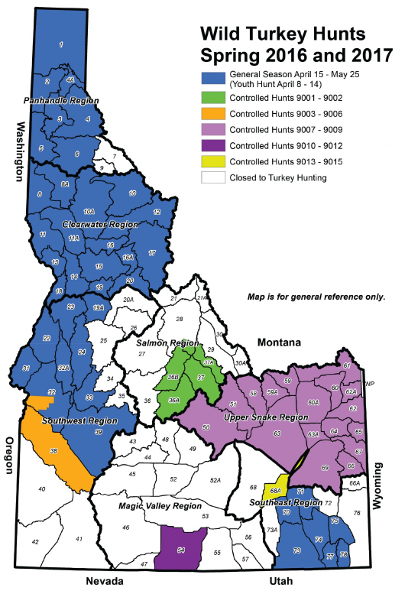IDFG Public Information Specialist
 |
Higher-than-normal snowfall in much of the state likely decreased turkey populations in some areas, but hunters should still find fair-to-good turkey populations depending on the region.
"In Southwest and Eastern Idaho we anticipate populations to be down based on field reports, turkey populations remain good in the Clearwater and Panhandle regions," said Jeff Knetter, upland and migratory bird coordinator.
Knetter explained turkeys typically cope with winter differently than big game. They typically seek out feed from agriculture operations, such as feed lots and feed lines for livestock.
In areas where that's not an option, they can have difficulty surviving winter if they're unable to get natural food off the ground. Fish and Game in cooperation with the National Wild Turkey Federation fed some birds during winter the Cambridge, Council and Garden Valley areas to help them get through winter.
Hunters are also warned that many areas have experienced flooding during late winter and early spring, so they should double check access to their favorite hunting spots. They might also encounter lingering snowdrifts that block them from their hunting spot.
Here are overviews from each Idaho region by regional wildlife managers:
Panhandle Region
Turkey season in the Panhandle is looking quite good despite the snow that accumulated in the lower elevations this winter. Wintering turkeys are typically associated with agricultural land, often around livestock feeding operations, so food is usually available.
Although the region had at near-normal winter snowpack, the winter did not begin in earnest until mid-January and snowfall in December and early January was below normal, so turkeys were not stressed for a long period. Things are now opening up and we’re seeing a very nice spring greenup due to the abundant moisture.
A challenge for turkey hunters this year might be access due to poor road conditions due to flooding, but there should be abundant turkeys. During the spring season, hunters may purchase and use up to two turkey tags; only toms may be harvested in spring. As always, remember to respect private property, and ask first before you hunt there.
Wayne Wakkinen, Panhandle Region Wildlife Manager
Clearwater Region
Last fall was warm and wet and early winter and snow pack was below average. This winter has seen what would be historically more normal snowpack, but valley snow levels were above normal. Despite this, turkeys in the Clearwater appear to be doing well. Snow at lower elevations came off relatively early and turkeys have had the advantage of spring green up.
The largest challenge to Clearwater turkey hunters this year will also be access. Warm weather and rain on snow events have caused flooding, road washouts and slides. Additionally, snow is gone at lower elevations, but some hunters will find it difficult accessing some valley hunting spots because of snow drifts on roads at higher elevations.
Clay Hickey, Clearwater Region Wildlife Manager
Southwest Region
Turkey populations have been increasing steadily the last several years. However, this past winter was hard on turkeys in places experiencing prolonged deep snows. Turkeys along the lower Boise River appear to be doing well. Unit 38 and a portion of Unit 32 are controlled hunts and hunting in low country along waterways often requires landowner permission. The Fort Boise Wildlife Management Area in Unit 38 is open to turkey hunting for controlled-hunt tag holders.
Units 33 and 39 are general hunts with small turkey populations scattered throughout.
In the northern part of the region, the National Wild Turkey Federation provided feed to private landowners in several areas, which helped turkeys come through the harsh winter pretty well. Access will be limited at higher elevations until sometime in May.
There are turkey populations at Cecil D. Andrus Wildlife Management Area near Brownlee Reservoir. Motorized travel is restricted on the Andrus WMA until May 1, but walk-in hunting is open.
Hunters can also find Access Yes! properties with turkey hunting opportunities near Indian Valley, and north of New Meadows.
Rick Ward and Regan Berkely, Southwest Region Wildlife Managers
Magic Valley Region
The region has a limited number of turkeys in Unit 54, with most residing on the west side of the unit. Turkeys are limited to controlled hunts only in the region, and normal survival is anticipated after the winter.
Daryl Meints, Magic Valley Region Wildlife Manager
Upper Snake Region
In general, the Upper Snake has small populations, and the bulk of these turkeys are associated with the South Fork of the Snake River and Snake River riparian areas. Those areas likely had some winter mortality to further depress these limited populations. I would anticipate turkey densities to be slightly below what we have experienced over the last number of years. Hunting is limited to controlled hunts across the region.
Curtis Hendricks, Upper Snake Region Wildlife Manager
Southeast Region
The region has severe winter conditions from late December through March, and anecdotal reports indicate that some winter mortality on turkeys occurred in isolated areas. We anticipate turkey densities to be lower than in previous years. However, turkey numbers were extremely high this past year, and despite some winter mortality, there should still be robust turkey populations for hunters to enjoy. During the early period of the spring season, hunters might find turkey distributions to be slightly different due to lingering snow at higher elevations.
Zach Lockyer, Southeast Region Wildlife Manager
Salmon Region
The region has low turkey densities, about 400 in Custer County and about 125 in Lemhi County. There are very limited controlled hunts for those birds. The region likely had some winter mortality to further depress these limited populations and hunt success. Where the turkeys occupy lower elevations in the region, access will not be a problem due to snow.
Greg Painter, Salmon Region Wildlife Manager